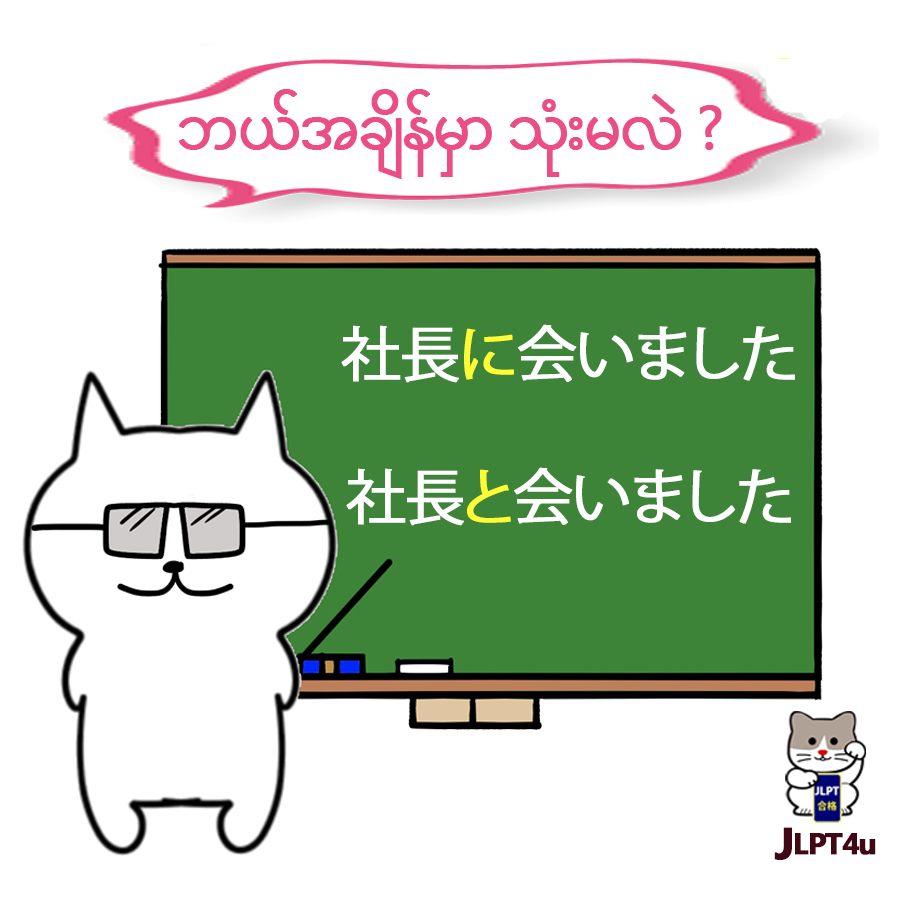に と の違い – Explained with Examples
Understanding the difference between the Japanese particles 「に」(ni) and 「と」(to) is important for JLPT N4 or N3 learners, especially when describing actions involving other people, communication, or changes in state. Both particles can be translated as “to” or “with” in English, depending on context, but they convey different nuances.

Key Difference (1): Meeting Someone
📌 Examples:
- 社長に会いました
(しゃちょう に あいました)
→ I met the company president. - 社長と会いました
(しゃちょう と あいました)
→ I met with the company president.
🔍 Explanation:
Both sentences are grammatically correct and mean “met the company president.”
However, the nuance is different:
- に (ni):
Implies one-sided action, such as a lower-ranking person (e.g., employee) going to meet someone of higher status (like the president). Shows direction or target of the action. - と (to):
Implies a more equal relationship, where both sides meet each other voluntarily or mutually. Implies cooperation or interaction.
Key Difference (2): Talking to Someone
📌 Examples:
- Aさんが Bさんに 話をした。
→ A spoke to B. - Aさんが Bさんと 話をした。
→ A spoke with B.
🔍 Explanation:
- に (ni):
Shows a one-way conversation. A spoke to B, possibly without B responding. - と (to):
Indicates mutual communication. A and B had a conversation with each other.
This distinction is important for expressing the directionality and nature of communication.
Key Difference (3): Change in State
📌 Examples:
- 晴れに なりました
(はれ に なりました)
→ It became sunny. - 晴れと なりました
(はれ と なりました)
→ It turned out to be sunny (unexpectedly).
🔍 Explanation:
- に (ni):
Used for natural or expected changes in state, such as weather improving over time. It naturally became sunny. - と (to):
Used when a result is unexpected or surprising. Often implies a dramatic or emotional change. After stormy days, today it surprisingly turned out sunny.
Summary Table: に vs. と
| Usage Example | に (ni) | と (to) |
|---|---|---|
| Meet someone | Direction, lower to higher rank | Mutual meeting |
| Talk to someone | One-sided talking | Mutual conversation |
| Change in state | Natural change | Unexpected outcome |
Additional Notes for Learners:
- The particle に generally marks a target, destination, or recipient of an action.
- The particle と often means “with” or “and”, indicating togetherness or mutual action.
JLPT Tip 💡:
These subtle differences often appear in JLPT N4 or N3 grammar and vocabulary sections. Pay attention to the relationship between the people or the emotional nuance of the sentence to choose the right particle.
Related Grammar Points:
- に:used with verbs like あげる、教える、話す、会う
- と:used with verbs like 一緒に~する、話し合う、結婚する
- に・と both can follow the same verb, but nuance changes the meaning.
